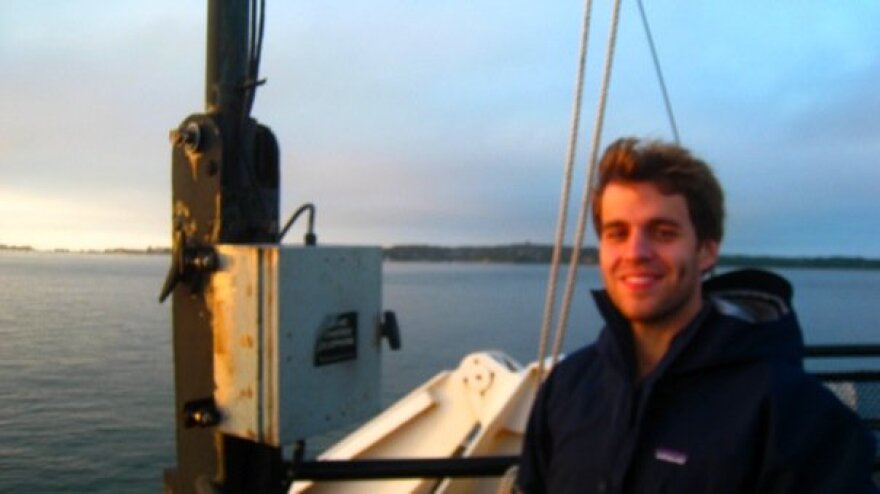As part of WCAI's exploration of the future New England's fisheries, we're talking to the many people who are intertwined with the culture of fishing. They may be fishermen, scientists or - in this case - an artist. Joseph Warren is a painter who grew up around the ocean in Massachusetts. His paintings are reflections of his love for the sea, and feature fish, whales and other sea life.
Where in Massachusetts did you grow up?
Brookline is my hometown, but I was also very lucky to spend portions of my summers in Woods Hole and the coast of Maine. My great grandparents were Dr. Edward Browning Meigs and Margaret Wister Meigs.
My great grandfather used to be involved with MBL.
This is on my mother's side of the family. As a result, I was very lucky to inherit 1/12th of a Woods Hole house that is shared with my aunts, uncle, and many cousins. I've been going for 28 years.
What is your earliest memory of fish or the ocean?
My first clear memories of fish come from my time as a seven year old enrolled in the Seashore Life class at The Children’s School of Science in Woods Hole, MA. We clambered about the rocks, hunting for crabs by dangling chicken drumsticks from string. We also collected other various small fishes and invertebrates for a class aquarium, which were a great source of pride at parents night before all the specimens were returned to their original environments at summer’s end.
Are you a fisherman?
I fish a few times a year- mostly in Woods Hole and always from the shore. Compared to some people I know, I am not a very adept fisherman, and usually only catch one of four things: a bluefish, a below-the-size-limit striped bass, a sea robin, or nothing. Even when I catch nothing, being near the ocean is something I love very much.

Where did the name Pescadotes come from?
A close friend of mine actually came up with the name. When I decided I was going to first start posting paintings of fish on the internet, I had no idea what to name the website. One of my reasons for starting www.pescadotes.com was that I really wanted to impress people with the immense size of some marine species. When I told this to my Spanish-speaking friend, he suggested pescadotes and it just stuck.
As far as I know, Spanish speakers rarely (if ever) use the word pescadotes, but it is the augmentative of pescado, the Spanish word for a caught fish (that is used for food). Theoretically, pescadotes means big, caught fishes (pescaditos would be small, caught fishes).
What are your paintings based on? (Live fish? Fish you've caught? Photographs?)
Before any painting begins, I will spend a lot of time researching different photos and scientific illustrations of a fish. From this research, I get an idea of body form and how I want to draw a base sketch. At the grocery store, I also spend a lot of time at the fish counter looking at scales, fins, and eyes. You’ll notice that my fish paintings are all two dimensional profiles and that is because fish field guides were the major inspiration for my work. I wanted the look and feel of pescadotes.com to be a more colorful and playful version of a scientific field guide.
Why include what fish eat with your paintings of them? Why not the scientific name or habitat or some other information?
The inclusion of diet is another homage to field guides. I think we like to be impressed with animals as hunters. At age of five, sharks became an obsession and I memorized about 40 different shark families via a colorfully illustrated book about sharks. And in third grade, my class would play “Predator, The Forest Food Chain Game,” which was a take on the classic card game “War,” only instead of a jack beating a six, a bobcat would eat a raccoon. On my site, I felt more people would identify with predator – prey relationships than habitat or classification information. Diet tells a quick and immediate story about life and death.
I have often thought about making a simple kids field guide on fish and if that project happened, I would include paintings and maps that illustrated habitat and range information.
For more of Joe's work visit www.pescadotes.com, then take our survey! Give us your opinion on The Future of New England's Fisheries.

striped bass (up to 6.5 ft, up to 125 lb)
eats: menhaden, bay anchovies, other small fish, crabs, squid









